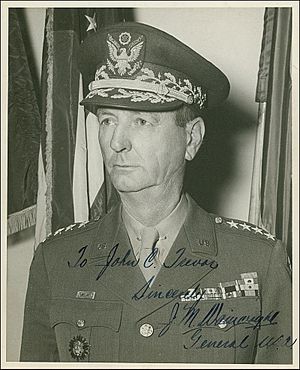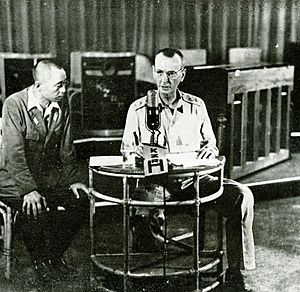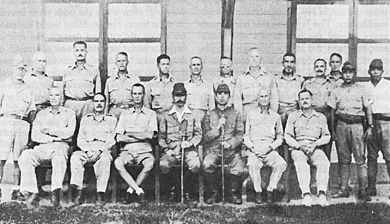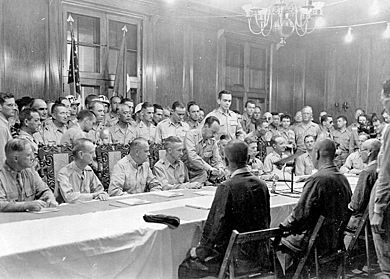Jonathan M. Wainwright (general) facts for kids
Quick facts for kids
Jonathan M. Wainwright
|
|
|---|---|

Wainwright after World War II and promotion to full General
|
|
| Birth name | Jonathan Mayhew Wainwright IV |
| Nickname(s) | "Skinny", "Jim" |
| Born | August 23, 1883 Walla Walla, Washington, U.S. |
| Died | September 2, 1953 (aged 70) San Antonio, Texas, U.S. |
| Place of burial | |
| Allegiance | United States |
| Service/ |
United States Army |
| Years of service | 1906–47 |
| Rank | |
| Commands held | 3rd Cavalry Regiment (United States) 1936–38 1st Cavalry Brigade 1938–40 |
| Battles/wars | Moro Rebellion
|
| Awards | Medal of Honor Distinguished Service Cross Army Distinguished Service Medal Medal of Valor |
| Relations | Jonathan Mayhew Wainwright I (great-grandfather) Jonathan Mayhew Wainwright II (uncle) |
Jonathan Mayhew Wainwright IV (born August 23, 1883 – died September 2, 1953) was an American army officer. He became famous during World War II. He was the top commander of Allied forces in the Philippines. He received the Medal of Honor for his brave leadership. This was during the fall of the Philippines to Japan.
Contents
Early Life and Military Training
Jonathan Wainwright was born at Fort Walla Walla in Walla Walla, Washington. People often called him "Skinny" or "Jim." His father, Robert Powell Page Wainwright, was also a U.S. Army officer. His father fought in the Spanish–American War and died in the Philippines in 1902.
Wainwright went to Highland Park High School in Illinois. He then graduated from West Point in 1906. He was a top student there.
After West Point, he joined the cavalry. He served in Texas and the Philippines. In the Philippines, he fought in the Moro Rebellion from 1908 to 1910. He became a captain in 1916.
Wainwright in World War I
In February 1918, Wainwright went to France during World War I. By June, he was a key assistant for the U.S. 82nd Infantry Division. He took part in important battles like Saint Mihiel and the Meuse-Argonne Offensive.
After the war, he served in Germany until 1920. He was promoted to major after returning to the United States.
Between the World Wars
After World War I, Wainwright taught at the Cavalry School. He also worked for the general staff from 1921 to 1923. He served with the 3rd US Cavalry Regiment in Virginia.
He was promoted to lieutenant colonel in 1929. He also attended advanced military schools. In 1935, he became a colonel. He led the 3rd US Cavalry Regiment. In 1938, he became a brigadier general. He then commanded the 1st Cavalry Brigade in Texas.
World War II Heroism
In September 1940, Wainwright was promoted to major general. He returned to the Philippines in December. He became the commander of the Philippine Department.
Defending the Philippines
When Japan invaded the Philippines in December 1941, Wainwright was a senior commander. He led Filipino and U.S. forces under General Douglas MacArthur. His troops tried to stop the Japanese invasion. They fought hard but had to retreat. They moved to the Bataan Peninsula and Corregidor island. These places guarded the entrance to Manila Bay.
In March 1942, General MacArthur left for Australia. Wainwright then became the top Allied commander in the Philippines. He was promoted to lieutenant general.
The Fall of Bataan and Corregidor
On April 9, 1942, about 70,000 troops on Bataan surrendered. This was due to a lack of food and supplies. On May 5, the Japanese attacked Corregidor. Wainwright's forces were running out of supplies and ammunition. To save lives, he decided to surrender on May 6.
Wainwright tried to surrender only his troops on Corregidor. He sent a secret message to Major General William F. Sharp on Mindanao. He told Sharp to take command of other forces. But the Japanese general, Masaharu Homma, demanded a full surrender. He held the troops on Corregidor as hostages. To protect his men, Wainwright agreed to surrender all forces in the Philippines.
General Sharp faced a tough choice. If he didn't surrender, the hostages on Corregidor could be harmed. Many of Sharp's Filipino soldiers refused to surrender. They joined a guerrilla movement instead. By June 9, all Allied forces had surrendered.
Prisoner of War and Liberation
Wainwright became the highest-ranking American POW. He was held in prison camps in the Philippines, Taiwan, and Manchuria. He suffered greatly during his three years in captivity. He became very thin and malnourished.
In August 1945, the Red Army freed him. He met General MacArthur shortly after.

On September 2, he watched the Japanese surrender aboard the USS Missouri. He then returned to the Philippines. There, he accepted the surrender of the local Japanese commander.
Wainwright was known as a "fighting" general. He earned the respect of his fellow prisoners. He worried that he had let his country down by surrendering. But when he was freed, he learned he was a hero. He received the Medal of Honor for his bravery.
After the War and Retirement
On September 5, 1945, Wainwright was promoted to four-star General. A huge parade was held in his honor in New York City. He was given command of important military units.
He retired from the army on August 31, 1947, at age 64. He felt sad to leave the military. He later served on company boards. He also spoke to many veterans' groups. He never held a grudge against General MacArthur.
Wainwright died on September 2, 1953, at age 70. He was buried at Arlington National Cemetery.
Awards and Honors
General Wainwright received many awards for his service.
- Medal of Honor: The highest military award in the United States.
- Distinguished Service Cross: The second highest military award for bravery.
- Army Distinguished Service Medal: Awarded for highly distinguished service.
- Prisoner of War Medal: Given to those who were prisoners of war.
- World War I Victory Medal: For service in World War I.
- World War II Victory Medal: For service in World War II.
- Medal of Valor (Philippines): The highest military honor in the Philippines.
Other Recognitions
- Army General Staff Badge
- Conspicuous Service Cross, State of New York
- Distinguished Service Medal, Commonwealth of Massachusetts
- Mexican Medal of Military Virtue, 1st Class
- Polish Order of Virtuti Militari
Private Honors
- Knights Commander of the Court of Honour (K.C.C.H.) (Freemasonry)
- Grand Lodge of New York's Masonic Achievement Medal
Places Named After Wainwright
Many places are named in honor of General Jonathan M. Wainwright:
- Fort Wainwright in Alaska is a U.S. Army post.
- U.S. Army Wainwright Station at Fort Sam Houston, San Antonio, Texas.
- Wainwright Drive in Pittsburgh, Pennsylvania.
- Wainwright Drive and Wainwright Elementary School in El Paso, Texas.
- The Veterans Hospital in Walla Walla, Washington is the Jonathan M. Wainwright IV Medical Center.
- A memorial to General Wainwright is on Corregidor Island.
- Wainwright Drive in Skaneateles, New York.
- Wainwright Street in Rockville, Maryland.
- Wainwright Drive in San Jose, California.
- Wainwright Avenue in Closter, New Jersey.
- Wainwright Court at California State University, Monterey Bay.
- There was a Wainwright High School in Tainan, Taiwan.
- The Jonathan M. Wainwright Award is given yearly by the Freemasonic National Sojourners.
- General Wainwright Drive in Lake Charles, Louisiana.
- Wainwright Heights, a housing area on Fort Hood, Texas.
- Wainwright Street in Benicia, California.
- Wainwright VFW Post 2185 in Panama City, Florida.
- Wainwright Elementary School in the Houston Independent School District.
In Film
In the 1977 movie MacArthur, actor Sandy Kenyon played Jonathan Wainwright.




